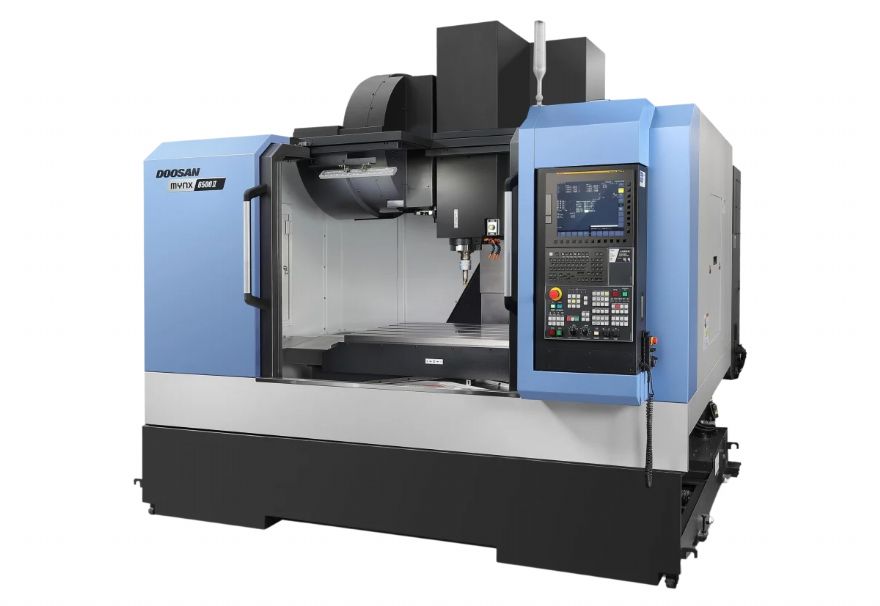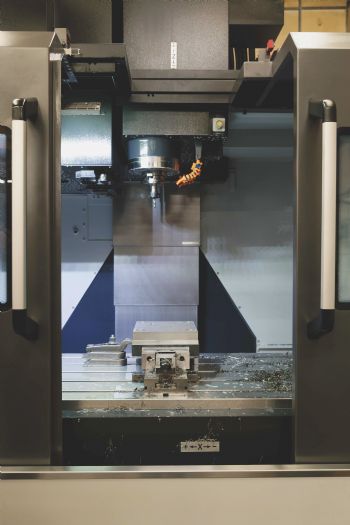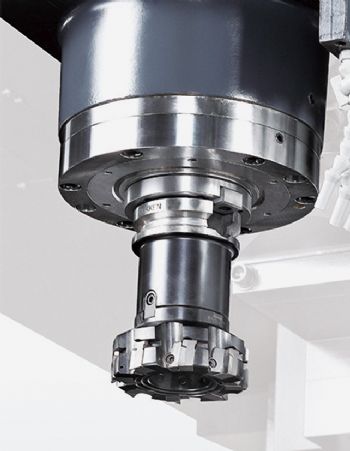
West Yorkshire-based
Bronte Precision Engineering Ltd, a leading precision sub-contract machining specialist, renowned for its in-house gear cutting expertise and its proven large and complex part machining capabilities, has invested in a new heavy-duty three-axis vertical machining centre (VMC) supplied by
Mills CNC, the exclusive distributor of DN Solutions’ and Zayer machine tools in the UK and Ireland.
The machine, a DN Solutions’ box guideway Mynx 6500/50 II, was installed at the company’s 16,000ft
2 manufacturing facility in Bradford in July, replacing an older Daewoo Mynx 540 BT40 machining centre which was orginally sourced from Mills CNC back in 2004.
Since being being commissioned, the new Mynx 6500/50 II equipped with the latest Fanuc 0iMP control and a powerful, gearbox-driven 6,000rev/min high-torque BT50 spindle, has been put through its paces machining a range of high-precision complex components, many of which were previously being machined on the Daewoo Mynx 540.
Bronte was acquired by Huddersfield-based
B&B Engineering Ltd in November 2024. The latter is a specialist precision engineering sub-contractor renowned for its high-quality CNC machining and HVOF coating services and expertise, and has the latest advanced CNC machine tools, automated thermal spraying booths and a dedicated quality and inspection department, replete with an in-house metallurgical laboratory.

Steven Haigh, now director of both companies, said: “B&B acquired Bronte as a going concern because I could see definite synergies between the two companies and the opportunity for both to achieve exponential growth. I was confident that by bringing together the shared experience and expertise of our staff, and by combining the technical resources of both companies, we could increase our manufacturing capacity and capabilities and improve our flexibility and responsiveness, enabling us to take on additional, higher added-value work and projects, and offer a better service to both new and existing customers.”
A few weeks after acquiring Bronte, a comprehensive and systematic audit and review of the company was undertaken, including the benchmarking of its 20-plus CNC machine tools and manufacturing equipment, and its machining and manufacturing processes. This identified process and system inefficiencies, as well as production bottlenecks and pinch-points.
Time to upgradeOne of the machines put under the microscope was the company’s Daewoo Mynx 540 — a 20-year-old heavy-duty three-axis VMC that according to Steven Haigh “had seen better days”. Over the last 20 or so years the Daewoo Mynx 540 had been a front-line manufacturing resource for the company, machining a range of complex, high-precision parts, typically machined and supplied in small to medium-size batches, for customers in a range of sectors, including oil and gas, power generation, marine, rail, food processing, power transmission, steel processing, gearbox manufacturing and electric vehicles.
Although the Mynx 540 was a rigidly designed box guideway machine, its relatively low-powered 145kW BT40 belt-driven spindle meant that it was not the ideal solution for the fast and efficient rough and finish machining of many hard and difficult-to-machine materials, such as Inconel, Monel, cast iron, stainless steel and duplex, typically machined by Bronte.
Mr Haigh explained: “The review of the Mynx 540 revealed that the machine was definitely ‘holding us back’. Part-cycle times were overly long as the machining processes employed had to take into account the limitations of the machine — it was clear that the Mynx 540 was a weak link in our production chain. To improve our performance, we made the decision to replace it with a new, high-performance, heavy-duty machining centre. As a consequence we did our homework, drew up a detailed new machine tool technical specification checklist and approached the market with our requirements.”
Box guideway constructionBronte’s machine tool checklist was comprehensive and identified a number of machine prerequisites which included: a rigid machine with a box guideway construction; a powerful, high-torque BT50 spindle with through-spindle coolant capability; a large capacity worktable and machining envelope; a generous-size automatic tool changer (ATC); in-process inspection/measurement (probing) systems; and the latest, most advanced Fanuc control.

Bronte approached Mills CNC as well as a number of other CNC machine tool manufacturers and suppliers, before ultimately, making the decision to invest in a new Mynx 6500/50 II based on the machine’s specification, its cost and availability, and the range of pre- and after-sales services offered by Mills CNC.
The Mynx 6500/50 II has so far been used to machine components for subsea applications made from Inconel castings for a long-standing customer and manufacturer of high-performance industrial pumps. Programmed off-line and machined in small batches, these parts are approximately 400 x 300mm in size, involve long and intensive roughing and finishing operations to complete each part and are characterised by their tight ‘tied up’ tolerances and stringent surface finishes. Part processing times with the new Mynx 6500/50 II are up to 50% faster than those achieved using the Mynx 540, justifying and vindicating the new machine tool acquisition.
Bronte’s new Mynx 6500/50 II VMC is equipped with a high-torque, gearbox-driven BT50 30kW 6000rev/min 617Nm spindle, a 30-tool servo-driven tool changer with 2.5sec tool-to-tool changeover time, and a 1,400 x 670mm worktable with a 1,300kg maximum table load. The machine was also supplied with a Fanuc 0iMP control, 20-bar through-spindle coolant capability and Renishaw OMP 600 and OTS workpiece and tooling probing systems.
Mr Haigh said: “The Mynx 6500/50 II is a powerful, accurate and flexible machining centre that, in just a few short weeks, has proved its worth. The machine’s rigidity, box guideway construction and powerful BT50 spindle with through-spindle coolant capability, has enabled us to significantly improve our productivity and process efficiencies, and the ability to ramp-up speeds and feeds and take more aggressive depths of cut have dramatically improved part-cycle times.”
He concluded: “The machine is still being ‘bedded-in’, so to speak, but I am confident that once we are more familiar with all of its onboard technologies, we will be able to hit repeatable accuracies of +/-0.05mm down to +/-0.03mm on selected features.”